Essential Guide to Backyard Compost Bins
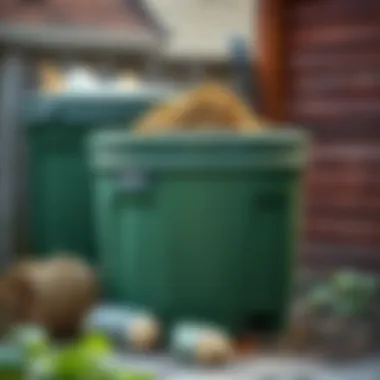
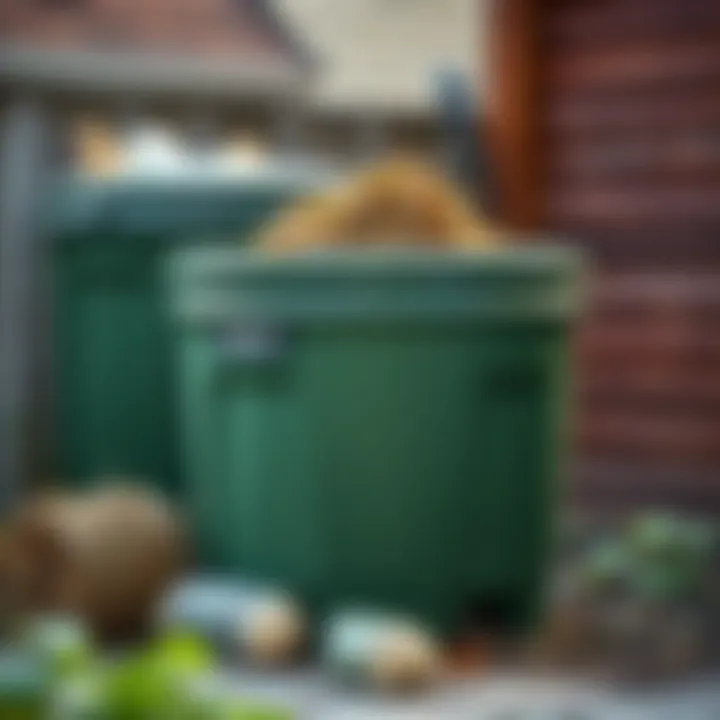
Overview of the Topic
Composting is often seen as a cornerstone of sustainable gardening practices. As the world grapples with increasing waste and environmental degradation, composting emerges not just as a personal endeavor, but as a global necessity. Backyard compost bins serve as microcosms of this larger movement, turning everyday organic waste into valuable nutrients for the soil. This process, when properly understood and implemented, can make an impactful difference in both individual gardens and the broader ecosystem.
In essence, backyard composting provides a dual benefit. It reduces waste sent to landfills and fosters healthier soil for plants. On the surface, the benefits seem simple, yet the implications run deep. The ultimate goal is to cultivate not only a thriving garden but also an awareness about resource cycles and sustainability practices.
Understanding the various types of compost bins, how to construct them, what materials to use, and the benefits they offer is essential. This guide aims to take you through these various aspects, empowering you to take action in your own yard.
Background Information
Historically, composting has roots in ancient agricultural practices. Farmers recognized the value of returning organic matter back to the soil, thus promoting fertility for future crops. Fast forward to today, and composting has transformed into a practice commonly embraced by eco-conscious individuals and communities.
The significance of this topic cannot be overstated, especially considering the rising challenges posed by climate change and urbanization. As we seek to manage resources more effectively, backyard compost bins serve as an accessible and effective method for individuals to contribute to the health of the planet. This understanding is crucial for current and future gardeners, conservationists, and even urban dwellers looking to reduce their carbon footprint.
Current Status and Challenges
Despite the apparent benefits of backyard composting, several obstacles remain.
Current State of Organic Waste Management
The landscape of waste management is shifting. According to studies, about 30-40% of municipal waste comprises organic materials, much of which can be composted. However, many people are still unaware of the potential benefits that backyard composting can bring. This leads to a situation where resources are wasted, both in landfills and on non-sustainable gardening practices.
Challenges Facing Composting Practices
Among the various hurdles are:
- Lack of Awareness: Many individuals still do not fully understand how composting works or its wider ramifications.
- Space Constraints: Urban living often limits yard size, preventing individuals from composting effectively.
- Improper Practices: Newcomers may struggle with the complexities of compost bin management—balancing greens and browns, maintaining moisture levels, and avoiding odors.
These challenges may seem daunting, but the potential for effective education and implementation is there.
Sustainable Solutions
Addressing these challenges requires a multifaceted approach, one rooted in education and community engagement.
Exploring Sustainable Practices
- Community Workshops: Local governments and environmental NGOs often hold educational sessions about composting. Participating in these can enhance understanding and practical skills.
- Utilizing Online Resources: Websites like EPA.gov offer handy guides and tips for successful composting.
- Neighborhood Compost Groups: Joining or forming local composting clubs can provide support and shared resources. This enables individuals with smaller yards to still engage in composting through communal efforts.
Successful Case Studies
Take, for example, the initiative led by the city of San Francisco, which has implemented a comprehensive composting program. Their success demonstrates the power of organized efforts in transforming waste management practices. According to reports, the city has seen a significant decrease in organic waste disposal since the program's inception, showcasing how collective action can yield promising results.
Impact and Importance
The ramifications of widespread composting fill niches beyond mere gardening. It’s essentially about rethinking our relationship with waste and resources. The simple act of composting can reconnect us to natural cycles, impacting not just gardens but ecosystems at large.
- Ecosystems: Healthy compost contributes to biodiversity, enriching soil and promoting thriving ecosystems.
- Communities: Communities that engage in composting often experience stronger bonds through shared resources and knowledge.
- Future Generations: By instilling sustainable practices today, we prepare the soil—literally and figuratively—for future generations.
“The biggest benefit of composting may well not be about the compost itself, but the conversations it starts about sustainability.”
This insight accentuates the broader purpose of composting. It’s more than just turning waste into resources; it's a fundamental reshaping of how we approach our environment and community. Each bin, each pile, and each bit of compost nurtures not just plants but also a collective consciousness.
As you embark on your journey with backyard composting, remember: every small effort counts toward a sustainable future.
Intro to Composting
Composting plays a foundational role in sustainable gardening and waste management. In this section, we will delve into what composting truly means, its techniques, and its historical evolution. By understanding the essence of composting, one can better appreciate the immense benefits it brings not only to our gardens but also to the environment.
What is Composting?
Composting is the process through which organic waste decomposes naturally with the help of microorganisms. This transformation occurs in a controlled environment, where materials such as food scraps, leaves, and yard waste break down into nutrient-rich humus—often referred to as 'black gold' by gardeners.
It’s like nature's recycling program, allowing us to turn kitchen and garden waste into something beneficial instead of tossing it in the landfill. Imagine pulling out a rich, dark substance that feeds your plants, improving soil structure, and promoting healthy microbial activity in the garden.
Here are some key aspects of composting:
- Microbial action: The process relies on bacteria, fungi, and other microorganisms to break down materials. Warm temperatures often accelerate this decomposition.
- Aerobic vs. Anaerobic: Composting can be aerobic (with oxygen) or anaerobic (without oxygen). Aerobic composting is usually faster and results in fewer odors.
- Benefits for soil: Finished compost enhances soil quality, retains moisture, and provides necessary nutrients for robust plant growth.
In a nutshell, composting is not just about saving waste, it’s about fostering a healthy ecosystem right in your backyard.
History and Evolution of Composting
The practice of composting is not new; it dates back thousands of years. The ancient Egyptians are known to have buried their kitchen scraps in their gardens, promoting the growth of crops. Fast forward to the 19th century, the term "compost" emerged in horticulture literature, detailing the importance of organic materials in improving soil health.
The evolution of composting reflects changing agricultural practices. From the methodical techniques developed by farmers of yore to the modern compost tumblers available today, the art has transformed significantly. The rise of the organic movement in the late 20th century further fueled interest in composting, encouraging homeowners to adopt these methods for sustainable living.
"Nature does not hurry, yet everything is accomplished." — Lao Tzu
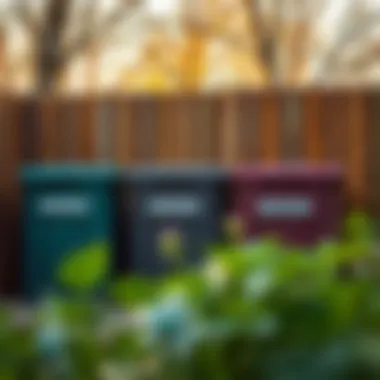

Today, composting is seen as an essential component in combating climate change. As awareness grows, this age-old practice has gained renewed relevance, offering an eco-friendly solution to the waste generated by urban and suburban households alike. With many cities implementing composting initiatives, our understanding and appreciation of this sustainable approach continue to mature, showcasing how history and evolution intertwine with modern gardening practices.
The Importance of Compost Bins
Compost bins play a crucial role in transforming kitchen scraps and yard waste into valuable organic matter that enriches soil. This transformation is essential for anyone interested in gardening or sustainable living. Using a compost bin simplifies the composting process, making it more manageable and efficient. It enables you to control the decomposition process, and the quality of the compost produced. Here, we will discuss the notable benefits of backyard composting and the environmental impact that these compost bins can have.
Benefits of Backyard Composting
Backyard composting provides multiple advantages, not just for you as a gardener, but also for the planet.
- Waste Reduction: Composting diverts organic waste from landfills. In fact, about 30% of what we throw away can be composted. By using a compost bin, you are actively reducing the amount of waste sent to landfills, helping to lessen the burden on waste management systems.
- Healthy Soil: Compost enriches the soil. When you add compost to your garden, it improves soil structure, texture, and aeration. Nutrients in compost support plant growth and enhance soil’s ability to retain moisture, which is particularly beneficial during dry spells.
- Cost-Effective: Creating your compost means less need for store-bought fertilizers and soil amendments. You can provide your plants with all they need directly from the compost bin. This is not only cost-saving but also more natural, allowing your garden to thrive organically.
- Biodiversity Boost: Compost attracts beneficial organisms, such as earthworms and microbes. These creatures play a vital role in maintaining a balanced ecosystem within your garden, promoting healthy plant growth.
"The best time to plant a tree was twenty years ago. The second best time is now." - Chinese Proverb
Incorporating compost into your gardening can truly extend beyond just individual benefits and touch upon broader environmental themes.
Environmental Impacts of Composting
The environmental impacts of backyard composting are significant. This practice contributes positively in several ways.
- Reduction in Greenhouse Gas Emissions: Organic waste that sits in landfills decomposes anaerobically, producing methane—a greenhouse gas far more potent than carbon dioxide. Composting mitigates this emissions issue, greatly reducing your carbon footprint.
- Water Conservation: Using compost improves water retention in the soil. This is especially crucial as we face increasing instances of drought. With compost, your plants require less watering, allowing you to conserve water resources.
- Soil Health Improvement: Healthy soil is a key player in a healthy ecosystem. It supports plant growth while also acting as a carbon sink, meaning it can store significant amounts of carbon. By enhancing soil health through composting, you contribute to combating climate change.
- Ecosystem Restoration: Composting can aid in restoring degraded land. When compost is applied to poor or barren soils, it can promote plant growth and improve habitat for wildlife, allowing them to thrive.
In sum, understanding the importance of compost bins is essential for anyone looking to make a meaningful impact in their gardens and beyond. By implementing composting in your backyard, you not only create rich soil but also engage in a larger dialogue about sustainability and environmental stewardship. It’s a simple yet powerful tool that supports both personal gardening goals and planetary health.
Types of Compost Bins
Understanding the various types of compost bins is crucial for anyone looking to compost effectively in their backyard. Choosing the right type directly influences how convenient the composting process will be and how quickly the materials will break down. Each type of compost bin has its unique features, benefits, and considerations that can affect not only the efficiency of composting but also the overall experience.
Open Compost Bins
Design and Structure
Open compost bins are among the simplest forms of composting systems. Essentially, they consist of a three-sided enclosure that allows for unrestricted airflow and temperature regulation. The open design facilitates easy access for adding materials and turning the compost, making it user-friendly for backyard gardeners. Some may opt for a framework made of wooden pallets or wire mesh, which can create a natural barrier while still permitting ventilation. This structure promotes decomposition through the natural circulation of air, which is vital for aerobic bacteria to thrive. However, it's important to note that an open design can also expose the compost to pests and external environmental elements, which can sometimes complicate the process.
Advantages and Disadvantages
The main advantage of open compost bins is their affordability and low-maintenance nature. They're easily constructed with materials that are often available at home. Furthermore, they allow for quick access to the compost pile, which encourages regular turning. However, potential drawbacks include exposure to excess moisture during heavy rains and the risk of strong odors if not monitored properly. Open bins may also attract rodents or other wildlife, which can be a concern for those living in urban areas.
Closed Compost Bins
Types of Materials Used
Unlike open bins, closed compost bins are fully enclosed units, often made of plastic or metal. They keep the compost materials safe from external influences such as weather and pests, enhancing the decomposition process. The materials used in closed bins can vary widely, from sturdy recycled plastic to steel, depending on the brand and model. High-quality closed bins often feature insulation to maintain optimal temperatures inside, which can significantly speed up composting. These bins typically also have features like vents and access doors that facilitate aeration while still safeguarding the compost from outside contaminants.
Pros and Cons
The primary advantage of closed compost bins is their ability to maintain temperature and moisture levels effectively, which results in faster decomposition. They mitigate the impact of weather, thus retaining consistent conditions for composting. However, they can come with a higher initial cost and may require more effort to set up and manage. Additionally, without careful monitoring of moisture levels, the enclosed nature can lead to issues like anaerobic decomposition, which creates unpleasant odors and slows down the composting process.
Tumblers and Aerobic Bins
Mechanics of Tumbling Composting
Tumbling composters, also known as aerobic bins, operate on a distinct principle. These bins are typically mounted on a frame, allowing for rotation, which actively aerates the compost as it is mixed. This twisting motion ensures that organic materials are evenly distributed and helps accelerate the breakdown process. The design commonly includes an insulated shell to help maintain temperature, enhancing microbiological activity. Tumbling composters are particularly appealing because they minimize the physical labor required to turn the compost, appealing to gardeners who may have physical limitations.
Efficiency and Maintenance
Tumbling composters boast a reputation for efficiency. Their design allows for quicker composting cycles due to optimal aeration and temperature control. Despite their benefits, they necessitate regular monitoring and maintenance to prevent over-filling and ensure proper balance between carbon and nitrogen materials. Sometimes, it can be a challenge to maintain the right moisture content within a tumbler, and excessive moisture could lead to a less effective process.
Vermicomposting Systems
Intro to Worm Composting
Vermicomposting, or worm composting, brings an element of nature directly into the composting process. Utilizing red wigglers or other composting worms, this method harnesses the natural breakdown process through digestion. These worms not only consume organic waste but also produce nutrient-rich castings, enhancing the fertility of your garden. The allure of vermicomposting lies in its ability to handle kitchen scraps, turning waste that might otherwise end up in a landfill into valuable compost.
Setting Up a Vermicompost Bin
Setting up a vermicompost bin is a straightforward process that requires minimal space. A typical bin includes a few layers with bedding made of shredded paper or coconut coir to keep worms comfortable and allow for aeration. It's crucial to keep moisture levels just right—too dry and worms could die, too wet and you risk creating an anaerobic environment. The beauty of a vermicompost bin is that it not only recycles organic waste but also produces an exceptionally fertile addition to your gardening efforts. However, it does require a bit of patience to learn how to balance the worm's needs with your composting goals.
Key Components of Composting
Composting isn’t just tossing scraps in a pile and hoping for the best. To really get the ball rolling, one has to understand several essential components that play a significant role in the effectiveness of the composting process. Recognizing these elements can help you fine-tune your backyard operation, turning kitchen waste and yard debris into rich organic matter for your garden. The key components of composting can be summarized into suitable materials, the importance of the carbon-to-nitrogen ratio, and effective practices for maintaining the compost pile.
Suitable Materials for Composting
Choosing the right mix of materials is the backbone of a healthy compost system. Two main categories of materials are required: green materials and brown materials.
Green Materials
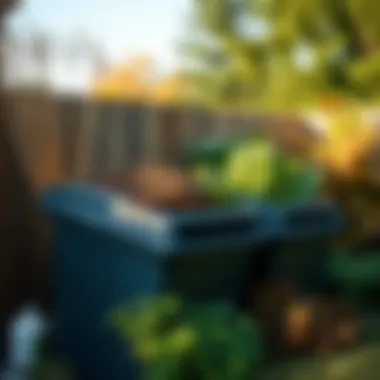
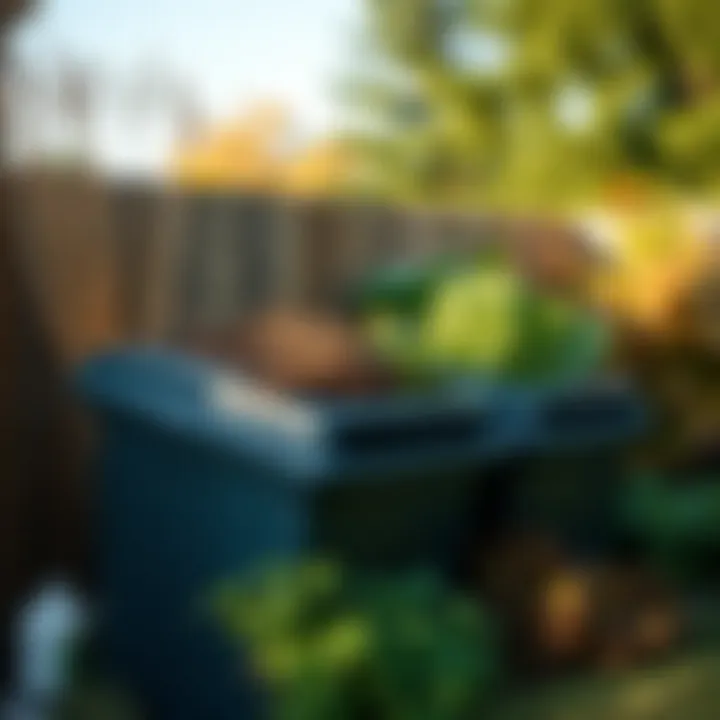
Green materials are typical nitrogen-rich items, which provide the essential fuel for the composting process. Think of freshly cut grass, vegetable scraps, coffee grounds, and even green leaves. These materials are not only easier to find but they also decompose faster than browns. If you think about it, it’s the lush look of vibrant greens that can give an instant energy boost to your compost.
However, there’s a catch. If overused, green materials can lead to a slimy, smelly mess. Finding the right balance with brown materials is crucial to create a well-rounded compost. Thus, the key characteristic is their nitrogen content, which makes them the star player when it comes to energizing the composting process.
Brown Materials
On the flip side, we have brown materials, which are carbon-rich. Items like dried leaves, twigs, straw, and newspaper are all part of this group. These materials serve two significant purposes; they help absorb excess moisture and contribute vital carbon that composting microorganisms need.
Consider brown materials as the slow-cooked factors that maintain the necessary structure within the compost. They add air pockets that keep the pile aerated. This keeps it from becoming a sodden mess, ensuring decomposition is efficient. Overdoing these materials, however, can slow down the process, making it take ages to turn scraps into usable compost.
Common Errors to Avoid
When it comes to composting, some mistakes can trip you up. One common error is failing to achieve the right balance between green and brown materials. Imagine a seesaw where one side constantly tips over – that’s akin to your compost if it leans too heavy in one direction.
Another blunder relates to the types of material chosen; adding meat, dairy, or oils can attract pests, creating a headache instead of nourishing your garden. Lastly, neglecting to turn the compost can choke off aeration, which is essential for decomposition. This simple act can make a world of difference, moving it from a stagnant pile to a bubbling source of nutrient-rich earth.
Understanding the Carbon-to-Nitrogen Ratio
The carbon-to-nitrogen (C:N) ratio is fundamental to successful composting. This ratio typically looks to aim for about 30 parts carbon to 1 part nitrogen. Why this balance? It’s like making a perfect recipe—too much nitrogen and your compost pile may smell like a landfill, while too much carbon will retard the heat and decomposition process.
A proper C:N balance ensures that microorganisms have the right mix of nutrients to thrive, keeping your compost active and efficient. Monitoring this ratio helps in adjusting materials used, fine-tuning your composting technique. Ultimately, understanding and implementing appropriate ratios, alongside those suitable materials, contributes mightily to achieving genuinely usable compost.
As you set foot on this composting journey, remember it’s all about understanding these components, ensuring they work in harmony. The right materials, a mindful approach to ratios, and avoiding common pitfalls can turn that heap of scraps into black gold.
Setting Up Your Backyard Compost Bin
Setting up a backyard compost bin is more than just throwing some kitchen scraps and yard waste into a pile. It’s about creating a sustainable system that turns organic waste into nutritious compost, enhancing your garden's soil health while reducing landfill contributions. This section encompasses crucial elements that ensure a successful composting venture.
Selecting the Right Location
When it comes to composting, location matters. Choosing the right spot for your compost bin will influence factors like aeration, moisture retention, and accessibility. Look for a well-drained area that receives a mix of sunlight and shade. Too much sun can dry out the compost, while too much shade can cause it to break down slowly. An ideal spot allows you to easily toss in new materials without too much effort, and it should be close to your kitchen so transporting scraps is a breeze.
"The best compost is made in the right place, where the benefits of sun and shade play a part in the process."
Constructing Your Compost Bin
Choosing Materials
When constructing a compost bin, the materials you select are pivotal. Wood is a commonly favored choice; it provides durability and a natural aesthetic. However, metal and recycled plastic bins are increasingly popular for their longevity and ready-to-assemble options. Each material has unique properties: wooden bins allow for airflow, metal bins resist pests, and plastic models often have built-in aeration.
The choice of materials should reflect the specific needs of your garden. For example, untreated wood is environmentally friendly but may rot faster in wet conditions. Metal bins, while robust, may heat up too much. Understanding these characteristics aids in making a wise decision that will serve your composting goals well.
Basic Construction Guidelines
Constructing your compost bin doesn’t need to be rocket science, but there are a few basic principles that can guide you. Ensure that the bin has adequate airflow; this can be achieved through slats or holes. A bin of at least three feet on each side promotes ideal heat generation, which in turn speeds up decomposition. Additionally, think about ease of access; a removable front panel can simplify turning the pile.
The unique feature of these guidelines is that they promote both efficiency and user-friendly design. Keep in mind that simplicity is key; an overly complicated setup may deter usage. Using basic tools like screws and nails and aiming for a sturdy, without frills, construction is often the best route for a novice or seasoned gardener alike.
By thoughtfully setting up your backyard compost bin, you lay the groundwork for a healthy composting process that enriches your plants, serves your gardening ambitions, and contributes positively to the environment. Remember, the journey of composting begins with a wise choice of location and thoughtful construction that aligns with your personal gardening style.
Effective Composting Practices
Effective composting practices form the backbone of successful backyard composting. These practices don't just ensure that your compost bin produces nutritious compost efficiently, but they also help in maintaining an environmentally friendly approach to waste management. Choosing the right methods can lead to faster decomposition, better quality compost, and overall pleasant experiences throughout the composting process.
Layering Techniques
Layering is akin to crafting a lasagna—different layers create a balanced environment that is critical for the breakdown of organic materials. In composting, the ideal strategy combines both green and brown materials. Green materials—which include fresh grass clippings, vegetable scraps, and coffee grounds—provide nitrogen. On the flip side, brown materials, like dried leaves, cardboard, and straw, bring in carbon.
Creating layers should follow this general approach:
- Start with a base of coarse browns (like sticks) at the bottom for drainage.
- Alternate layers of greens and browns—aim for a ratio of about 1 part green to 3 parts brown.
- Top it off with some soil or finished compost to introduce beneficial microorganisms.
Using this method not only aids in air circulation but also helps retain moisture within the pile. Over time, these layers intermingle, and the microorganisms and worms do their magic, turning your kitchen scraps into black gold.
Turning and Aerating the Compost
Turning your compost is similar to stirring a pot of soup—regular agitation encourages even cooking. As materials break down, they generate heat, and if the pile isn't turned, the inner materials can become compacted and anaerobic, leading to unpleasant odors. Regular turning introduces oxygen, which is crucial for aerobic microorganisms that play a vital role in decomposition.
Benefits of aerating your compost include:
- Faster breakdown of materials
- Reduction of foul smells
- Prevention of unwanted pests
- Improved nutrient distribution throughout the pile
To effectively aerate, aim to turn your compost every few weeks, using a pitchfork or shovel, ensuring all layers are mixed well. This process can significantly enhance your composting experience.
Monitoring Moisture Levels
Moisture is the unsung hero of composting; too much can drown your compost, while too little can leave it parched. It's crucial to strike a balance, as moist (but not soggy) conditions promote the activity of microorganisms.
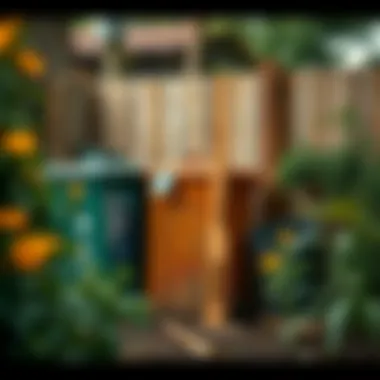
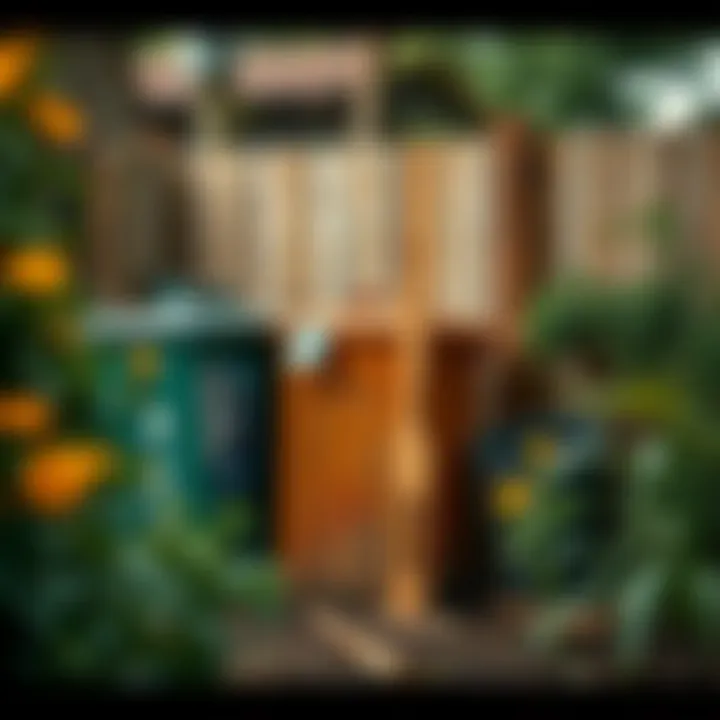
"A compost pile should feel like a wrung-out sponge—damp but not dripping."
To monitor moisture levels effectively:
- Check your compost regularly for dryness or excess moisture. If it's too dry, sprinkle some water or add new greens; if it's too wet, turn the pile to aerate and help with evaporation.
- Avoid using materials treated with pesticides or herbicides, as they can negatively impact the microbial activity essential to your composting process.
Taking these steps will ensure that you not only maintain a thriving compost ecosystem but also make the best out of your organic waste, turning it into a resource rather than a liability.
Troubleshooting Common Composting Issues
In the intricate dance of composting, challenges can arise even for the most dedicated gardeners. Understanding and addressing these issues plays a pivotal role in the overall success of your composting efforts. The more familiar you are with potential problems, the easier it becomes to cultivate a fruitful composting experience. By resolving issues promptly, composters can ensure a healthier end product and a more pleasant backyard atmosphere.
Identifying Unpleasant Odors
Unpleasant odors are perhaps the most notorious challenge in composting. They can occur for various reasons, but they predominantly signal that something is amiss within your compost bin. A strong d臭 odor might suggest that the bin is too wet or that the materials are out of balance. When the compost bits become too compacted, oxygen can’t reach them, leading to anaerobic conditions which, in turn, produce foul smells.
To tackle this problem:
- Assess Moisture Levels: Check if your compost is overly wet. If it is, add more brown materials (like dry leaves or newspaper) to absorb excess moisture.
- Turn the Pile: Aeration is key. Turning the compost pile helps introduce oxygen, preventing that smelly anaerobic state.
- Balance Greens and Browns: Aim for a proper mix of green (nitrogen-rich) and brown (carbon-rich) materials. An imbalance can throw the entire system out of whack.
Taking these steps can alleviate odors and enhance the efficiency of your composting process. Regular monitoring can help you detect issues before they escalate.
Dealing with Pests
Pests can be another unwelcome aspect of backyard composting. While a small number of insects are beneficial in the breakdown process, larger pests can cause problems. Rats, raccoons, and even stray dogs may be drawn to your compost pile, causing destruction and havoc. Preventing these nuisances requires some forethought:
- Choose the Right Bin: Consider using a closed compost bin or a tumbler, which can deter larger animals and keep your materials secure.
- Avoid Food Scraps: Steer clear of adding meat, dairy, or oily foods to your compost, as these are like a buffet for pests. Stick to vegetable scraps, fruit peels, and yard waste.
- Utilize Barriers: Installing wire mesh at the bottom of your compost bin can keep critters from burrowing in while still allowing drainage.
Ultimately, staying on top of pest control is crucial. By implementing preventive measures, you can enjoy a vibrant compost ecosystem without unwanted visitors.
Proper compost management not only boosts your garden but also reduces waste and nurtures a healthier environment.
In closing, know that troubleshooting problems in your compost bin doesn’t have to be a daunting task. By identifying and addressing common issues swiftly, you'll cultivate a more productive composting experience!
Using Finished Compost
Using finished compost is a crucial aspect of the composting process. It represents the culmination of the composting journey, transforming kitchen scraps, yard waste, and other organic materials into a rich, nutrient-dense soil amendment. Understanding how to use finished compost effectively can substantially enhance the quality of your garden and contribute significantly to sustainable waste management practices.
Recognizing When Compost is Ready
Identifying when compost has reached its peak maturity is vital for achieving the best gardening results. A few indicators signal that your compost is ready to use:
- Appearance: Finished compost should look dark, crumbly, and soil-like, resembling rich chocolate cake rather than the original materials that went into it.
- Smell: A pleasant earthy smell indicates that the compost has matured properly. If it emits a foul odor, it may need more time or a stir to aerate it.
- Temperature: Mature compost consistently cools to ambient temperature. If it remains warm or has hot spots, more time is needed for it to stabilize.
Keep an eye on these signs as they can vary based on the materials used and environmental conditions. A well-timed use of compost can yield remarkable results in your garden.
Applications of Compost in Gardening
Finished compost has various applications in gardening, each contributing uniquely to improving soil health and plant vitality. Not only does it enrich the soil, but it also supports eco-friendly practices in your backyard.
Enhancing Soil Quality
One of the most significant contributions of compost is enhancing soil quality. When applied to garden beds, finished compost improves soil structure, promoting better aeration and drainage. This ultimately leads to healthier root systems for plants. Moreover, compost acts as a reservoir for moisture, reducing the need for frequent watering.
Key characteristics that make enhancing soil quality using compost a popular choice include:
- Nutrient Density: Compost enriches soil with vital nutrients, providing plants with necessary minerals for growth.
- Microbial Health: It supports a vibrant ecosystem of beneficial microbes that govern soil health.
In this article, the unique feature is the dual benefit of compost: enhancing soil texture while providing nutrition. The advantages greatly outweigh disadvantages, as the occasional imbalance in nitrogen can easily be corrected with the right knowledge.
Reducing Waste
The use of compost also has a powerful environmental aspect: it helps reduce waste. By converting kitchen scraps, garden waste, and organic materials into compost, we can significantly decrease the amount of trash sent to landfills. This not only saves space but also lowers greenhouse gas emissions, making it an eco-conscious choice.
The key point characterizing waste reduction is:
- Resource Recovery: Rather than discarding food scraps, they become a valuable resource for improving garden health.
This dual advantage of reducing waste while enhancing garden health makes it a beneficial practice. However, a common issue can arise when not managed properly. If non-organic materials enter the compost mix, it defeats the purpose of waste reduction and can pollute the compost.
In summary, using finished compost effectively leads to improvements in both garden vitality and the environment, showcasing the sustainable methods that every gardener should embrace.
End
In wrapping up our exploration of compost bins, it’s clear that composting offers a myriad of benefits that extend far beyond merely reducing the amount of waste sent to landfills. The act of composting not only aids in decreasing greenhouse gas emissions but also contributes to maintaining healthy soil, which is critical for sustainable gardening practices. Backyard composting encourages individuals to take responsibility for their waste and engage with their environment in a meaningful way.
The future of composting practices should revolve around increasing awareness and accessibility to composting systems. Advances in technology, such as mobile apps that help track composting efforts or innovative bin designs that cater to various backyards, can enhance the composting experience for everyone. Moreover, as society increasingly shifts towards sustainability, it’s important to highlight the necessity of educating future generations about responsible waste management practices.
There are several considerations that come into play when looking toward the future of composting:
- Education and Outreach: Creating programs in schools or community centers to teach composting basics.
- Local Regulations: Advocating for policies that support composting initiatives and provide incentives to households.
- Product Development: As the market for eco-friendly gardening products grows, fostering innovation in compost bin designs can lead to more efficient composting systems.
"Composting is not just a chore; it’s a lifestyle choice that resonates with environmental stewardship."
To sum up, the act of composting, particularly through the use of compost bins, plays a pivotal role in nurturing our environment. By embracing this practice and advocating for its future, we can all contribute to a more sustainable and eco-friendly world. For anyone looking to deepen their understanding, resources like Wikipedia, Britannica, and various educational institutions (*.edu) can provide further insights into the diverse benefits and methodologies associated with composting.



